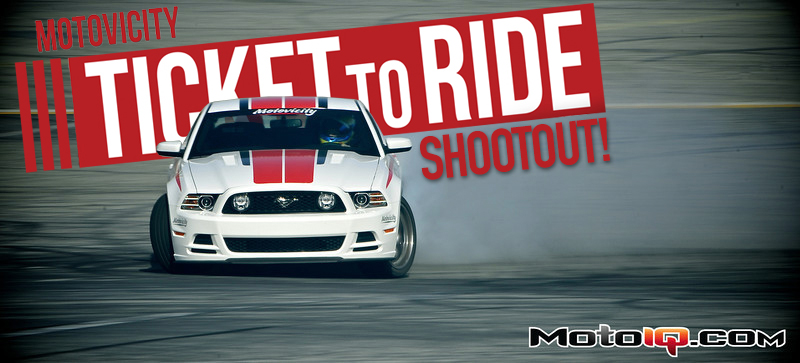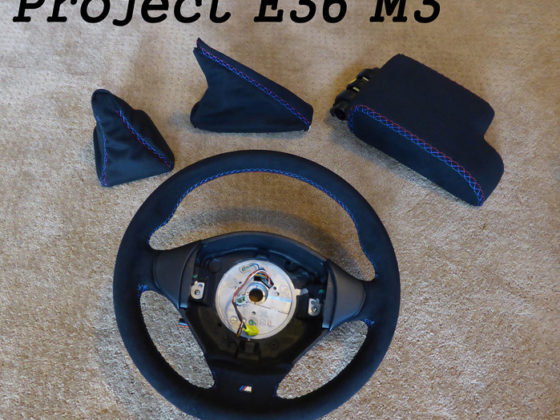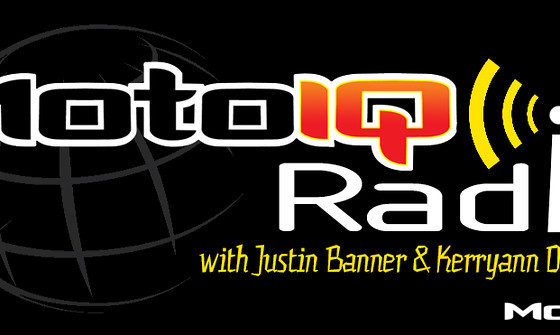,
Results
By now you are probably dying to know exactly how the cars performed. After collecting our data, we threw out the starting runs where our drivers were getting used to the cars, then we took out our obviously high and low runs that stood out as flyers. We then took the average of the repeatable data for each car. This is why our number are slightly different than the video you’ll see at the end.
Braking
Stock Mustang 60-0
Although the stock Mustang stopped in a respectably short distance, it was depending on all of its electronic nannies to keep the car straight on our banked surface. The stability control and ABS were very active and the car nose dived like crazy almost lifting the back wheels off the ground. With repeated hard stops we would feel a slight amount of pad fade which increased the pedal effort. Amazingly the Mustang still had a pretty short stopping distance of 110 feet.
Ticket To Ride Mustang 60-0
The Ticket to Ride Mustang was worlds more composed, stopping with little drama thanks to the KW and Whiteline suspension mods, The body motion was much more controlled and the car made better use of all 4 tires. The StopTech brakes pulled the car down repeatedly with no fade and had a nice firm pedal feel compared to stock. The stock car stopped in a very respectable distance but the TTR Mustang managed to better the stopping distance by 4 feet for an amazing distance of 106 feet, this is the sort of stopping distance that many more expensive cars can reach.
Stock FR-S 60-0
The stock FR-S also did really well bring it down from 60 mph in 114 feet. It is interesting to note that these would be supercar like numbers just a few short years ago. Unlike the Mustang, the FR-S was much more composed, feeling much more under control even if its braking distances were longer. We feel that the longer braking distances were largely due to the low rolling resistance stock all season tires which didn’t have a whole lot of grip. After repeated hard stops we could feel the the FR-S’ brakes fading slightly.
Ticket To Ride FR-S 60-0
The Ticket to Ride FR-S brought it all down in an amazing 102 feet. This is supercar territory. The car’s Eibach suspension kept the nose from diving helping the car utilize all for wheels better and the larger and stickier Yokohama tires helped greatly with more grip. The simple StopTech Sport brake upgrade helped with improved pedal feel and better ABS resolution through the braided steel lines. The StopTech pads were fade free and had more bite. The slotted rotors probably helped a small bit as well. We were really surprised at the improvement made to the FR-S’ brakes. StopTech is giving a really good bang for the buck here.

Acceleration
Stock Mustang 0-60
The stock Mustang with its big 5 liter V8 ripped the 0 to 60 in an impressive 5.03 seconds.
Ticket to Ride Mustang 0-60
The Ticket to Ride Mustang aided by extra traction off the line from the Whiteline/ KW suspension and Yokohama tires with additional power from the BBK Shorty Headers and Black Out cold air intake ran an improved 0 to 60 time of 4.73. This matches what many more expensive cars can do and is pretty impressive for just simple engine bolt ons. The TTR Mustang was the fastest car in a straight line by far.
Stock FR-S 0-60
The stock FR-S was not blazingly fast with a 0-60 time of 7.34, but for a naturally aspirated 2 liter, it was not too shabby. Considering that my dad’s old Fox Body 5.0 would do the same thing in 7 seconds and my old AE86 in 8.9 seconds, it is really not too bad. The stock limited slip allowed the car to launch well even with its wimpy stock tires.
Ticket to Ride FR-S 0-60
With a bunch of extra power from the HKS Supercharger and exhaust system and extra traction from the Eibach suspension, Exedy Clutch and Yokohama tires, the Ticket to Ride FR-S wins the award for the most improved acceleration with a 0-60 time of 6.04 seconds. This is a time that could smoke V8 Muscle cars just a few short years ago and is in line with cars costing much more. The Supercharger gives smooth linear power finishing with a rush towards the redline. This linear power delivery makes the car easy to launch. With excellent drivabilty the HKS system feels like how the car should have come stock from the factory. Is anyone at Scion reading this? Please give us more power!
Skidpad
Stock Mustang Lateral G
We ran a skidpad with a 100 foot radius that we laid out on the infield of Irwindale raceway. Our skidpad had a tighter than typical radius and was out on mostly green asphalt and was very dirty and bumpy, passing over some drainage areas so our numbers might be lower than what you might typically see in magazines. Like our other tests we threw out high and low fliers and took the average consistent data points.
The stock Mustang plowed its way around the skidpad in solid understeer recording an average G of .79 The tail could be coaxed out with power, but this resulted in very inconsistent lap times. The Mustang also exhibited a lot of body roll and was sluggish at the helm.
Ticket to Ride Mustang Lateral G
The Ticket to Ride Mustang was greatly improved, circling the skidpad at .86 G. Body roll was greatly reduced and the car was responsive to steering command. The car was night and day different from stock. The Mustang still steadily understeered and we felt that we could easily double the skidpad performance improvement with some shock, swaybar, alignment and tire pressure tuning. The great adjustability of the Whiteline and KW suspension allows a lot of set up leeway if you know what to do with it. Overall we were pretty impressed with the Mustang and how far it came from stock.
Stock FR-S Lateral G
Although the FR-S felt more nimble and better balanced than the Mustang on the skidpad, it had a lower lateral G circling the pad at .76 G. We feel that this is due to the lower performance and skinny stock tires more than anything. The FR-S exhibited a lot of body roll but somehow it didn’t feel as bad as the Mustang. The FR-S understeered around the skidpad, but not as badly as the nose heavy Mustang.
Ticket to Ride FR-S Lateral G
The Ticket to Ride FR-S essentially kept about the same balance as the stock FR-S but with greatly reduced body roll and more responsiveness. The Eibach suspension really helped make the car less twitchy and more controllable at the limit. The TTR FR-S circled the skidpad at .83 G. We were surprised that the number was this low as the car felt great. Like the Mustang we felt that we could easily double the improvement seen here with some dialing in of the suspension, alignment and tire pressures.

Road Course
Stock Mustang Lap Time
The Mustang wallowed, dived, squatted, plowed and oversteered around our roval. It was not fun to drive at all and even looked bad to the spectators. It took a lot of skill to turn a decent lap time but our pro drivers were good at that. The stock Mustang blundered its way around to a 33.61 second lap time, surprisingly good considering that the car looked like a train wreck out there.
Ticket to Ride Mustang Lap Time
The Ticket to Ride Mustang was much more composed and was night and day easier and more fun to drive. What surprised us is that it was not much faster than stock, turning a 32.64 second lap time even though it looked like it was hauling ass. We think it was because the car still had quite a bit of understeer. We are confident that we could get another two seconds improvement out of the car with some adjustment of the suspension. The Whiteline and KW suspension has a huge amount of tuning leeway and we could easily take advantage of that.
Stock FR-S Lap Time
Despite feeling a lot more composed and balanced than the Mustang, the stock FR-S was slower around the road course at 34.27 seconds. A lack of power is the most likely culprit as a lot of time was lost in acceleration.
Ticket to Ride FR-S Lap Time
The HKS power mods brought the TTR FR-S alive and it just edged out the Mustang with a lap time of 32.50 seconds. The car was also a lot more composed with less body motion and much better overall control. The balance was much like stock with slight understeer progressing to oversteer in late throttle. The modified car’s Eibach suspension made the understeer to oversteer transition less abrupt and easier to control. We felt that with some tuning we might be able to extract about a second to a second and a half from the car.
Conclusions
We were very pleased with how the cars came out. Both cars were very street livable with good ride quality and no drivability quirks at all. Neither car was too loud or too harsh.
Let us note that we made very little attempt to tune the cars other than how they were brought to the event. Just a little chassis tuning would have made a measurable difference and a good test session with either car would have made a huge difference, especially with road course lap times and skidpad performance.
You might wonder why is the “as delivered” setup on these cars is in need of tuning to optimize the car for track use? The main reason is liability. To make the car safe for potential knuckle heads, performance suspension companies, like the OEM manufacturers, must supply baseline settings to deliver a good amount of nice, safe and easy to control understeer.
Better companies have enough adjustment leeway so the enthusiast or racer can adjust the car to be more in line with their skill levels and the amount of daily driving streetabitly they are willing to sacrifice. The components used in the TTR cars definitely have that.
The Ticket To Ride cars have excellent streetability with little daily driving irritation, are reliable, get decent fuel economy, can be set up for track use and most importantly are fun to drive.
We could not ask for more than that!



